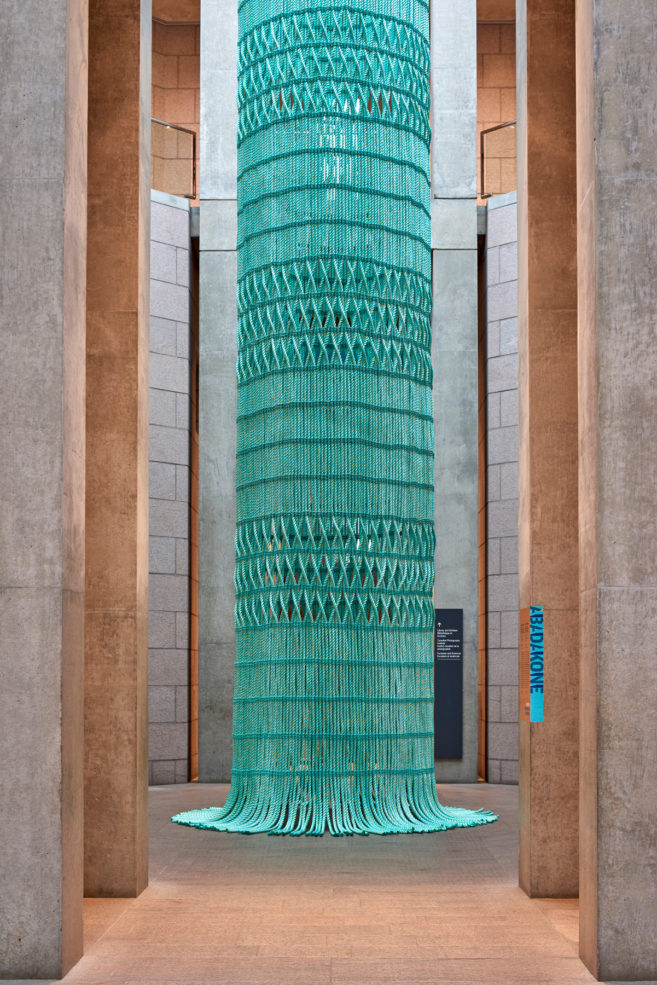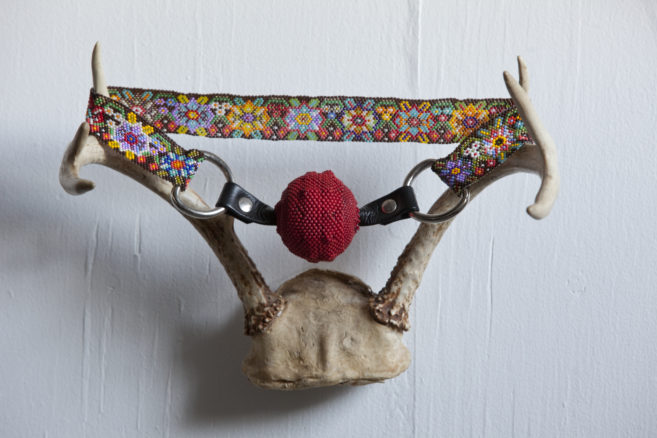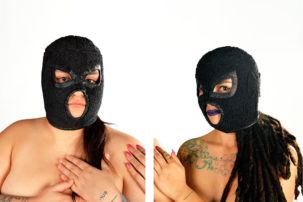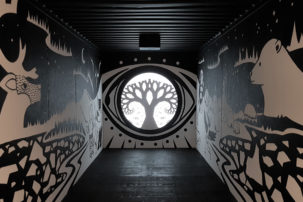I was kicked out, said I’m too loud; kicked out said I’m too proud.
–Janelle Monáe, “Crazy, Classic Life,” from Dirty Computer
When Janelle Monáe found out that she had been nominated for a Grammy for Album of the Year, she was live on CBS This Morning. Her reaction was inspired. Through tears she managed:
“This album is so much bigger than me. It’s not about me, it’s about a community of dirty computers, of marginalized voices. Being a young, black, queer woman in America, there was something I had to say…a group of people I wanted to celebrate…and I’m happy to be representing them. I hope they feel seen. I hope they feel heard. I hope they feel loved. And I hope they feel celebrated.”
For me, in 2018, Janelle Monáe was big praxis. For me, 2018 could be summed up by the aforementioned comment by Monáe. Monáe and I are part of a generation of queer and trans fem creators who are sick of working within industry structures of scarcity and cruelty—who just want to make work for the people they love, to ensure those peoples see their own future in cultural objects. I know this work of shining a light on love, of refusing industry cultures to make and take space for marginalized voices, isn’t easy. Of course, I’m ever grateful and connected to my mentors who brought me to where I am today. Don’t get it twisted: I am so lucky for the space those before me made. But I also see that the next gen of Indigenous art is a loving one. And that’s our power. It’s this love and solidarity for one another that has allowed us to truly reach a critical mass.
Which brings me to a new challenge that increased focus on Indigenous art within Canada’s art institutions brought to Indigenous art communities with in 2018: the institutionalization of Indigenous art in Canada. While BACA brought us a strong and thoughtful curation of feminist- and womanist-minded artists, BACA Indigenous art communities started asking: What NDNs are present at the table of institutionalized Indigenous art? Did increased funding for Indigenous art in Canada truly better the lives of all Indigenous artists, or a select few who know how to navigate institutional structures? More importantly, who are the non-Indigenous peoples benefiting from Indigenous art initiatives in Canada? In 2018 I learned these questions matter. As Richard Hill has noted, identity politics in institutional Indigenous art leads to a breakdown in honest art criticism. We are leaving behind a period in Indigenous art where Indigenous artists showing in major institutions were so few, that those few works being shown were seldom critiqued with the same rigour as non-Indigenous artists. Art industries are simultaneously, albeit slowly, coming out of period of crisis in art criticism. Art criticism has traditionally been a field monopolized by non-Indigenous writers who can’t help but approach Indigenous artworks voyeuristically and from an outside perspective. The result was a rhetoric of Indigenous exceptionalism. Indigenous art was often valued because of its supposed uniqueness and the integration of an Indigenous visuality within colonial institutions. But let’s be real: some Indigenous art, somewhere, has to be bad.
I have circulated within both sects: the institutionalized version of Indigenous art that centres around major institutions and institutional actors and Canada, and the community-based Indigenous art scene grounded in activism and activation, seen in the work of artists such as Erin Konsmo and Quill Violet Christie Peters (another emerging talent to watch). In community, love for Indigenous making, makers and communities is never just a “trend” made for white audiences. As we move past the reconciliation year, as I predicted, there is already noticeably less Indigenous art curation in Canada. Which raises the question: Do we trust an instructional Indigenous art that treats our communities as trends and bottom lines on their operational funds, as pretty distractions to mask the Liberal’s anti-Indigenous attitudes and policies?
I started this year struggling with where I would publish my book because Indigenous literary and art criticism communities, in Canada and internationally, were not where stories like mine fit as little as a year ago. I ended this year overwhelmed, having seen more smart, intersectional and beautiful curations of queer, trans and non-binary Native life than ever before in my life. Vanessa Dion’s beaded period stains in Rheanne Chartrand’s curation of “niigaanikwewag” at the Art Gallery of Mississauga was a personal favourite artwork of 2018. Jeneen Frei Njootli’s installation at the Sobey award exhibition was another of my favourites (so much so that I got in trouble with security for smelling the hide—it was worth it, though).
Niki Little and Becca Taylor’s curation of the Montreal Contemporary Native Biennale (BACA) brought us a diverse range of gender-variant and sexually diverse Indigenous life. The presence of Dayna Danger’s photograph series Sisters firmly situated her as that bitch, the bitch, of sxxy NDN art. Danger’s work Bebeschwendaam also appeared in “Li Salay” at the Art Gallery of Alberta, another notable show from 2018, curated by Amy Malbeuf and Jessie Short. “Li Salay” was the first group show that comprised solely Métis artists, of whom the majority were women and non-binary peoples.
Back at BACA, Kablusiak’s soapstone carvings of coping mechanisms, such as cigarettes and a menstrual cup, were a battle cry for this new queer-fem generation of Indigenous art. Raven Davis’s collaboration with dancer (and wife) LeeLee Davis was the visual documentation of queer love I had always been waiting for. Another highlight of 2018 was actually seeing Davis’s curation for Halifax’s Nocturne festival. Partners Ursula Johnson and Angella Parsons gave a touching performance entitled L’nuisimk: El-noo-we-simk: Speaking Indian that moved to different locations through the city throughout the night. The pair could be found teaching one another their family languages with a tenderness that showed that they, too, constituted a new family building a collective identity. Also at Nocturne, Jason Baerg and Jean-Sébastien Gauthier’s installation We Are Star People brightly dazzled in the night, taking viewers on a new media journey through Cree cosmologies. Coincidently, marijuana became legal the day of Nocturne, and some of the wily trickster artists types in town slipped me some gummies. A little buzzed, when I approached Baerg and Gauthier’s installation I felt disembodied and lost in their Cree star world. I often find myself jaded, having come a long way from the early affective experiences with Indigenous art that made me a critic. But Baerg and Gauthier reminded me of the physically moving power of community art (and THC edibles).
Choosing one or two shows that spoke to me this year is extremely difficult because there were so many that I didn’t get to give love to. That said, there were a two I’d like to mention. The first was a recent visit I made to Brandon with my Canadian Art colleague, where I saw “Theater From the Jungle.” I sat in the gallery for over an hour witnessing the stories of Maple Leaf factory workers, who also performed the highly repetitive and chronic pain inducing movements they continually undertake in their work for the factory. There was hesitancy in their words though, as if they knew the precarity of their situation and the risk they took in talking about the condition of their work. I was reminded that, in Indigenous activism and curation, solidarity with our kin across borders is important and contests a nationalist framework that limits our understanding of kinships connections, ties to nations that existed pre-colonization. It reminded me that everyone is Indigenous to somewhere, and some of our Indigenous siblings are struggling with displacement and migration crackdowns—yet somehow these narratives of solidarity have largely been missing from Indigenous art. I’m inspired by this new era of Indigenous art curation, one that doesn’t shy away from complex intersections.
Another personal favourite was seeing Amanda Strong’s solo show at Wanuskewin Gallery, curated by Felicia Gay. As a self-professed crybaby, I’ll admit that I’m moved to tears by art frequently. This show was no exception. Seeing Strong’s sets in person, I was truly in awe of the process and time it must take to for Strong to make her videos. Strong’s video Biidaaban was also in the show. If there is an Indigenous future, it’s Biidaaban. To see a figure that so resembles me running through a city late at night, saving the city environments they are connected to, rolling in a crew with spirit who get visions from Creation on their cell phone–like object made of stone and branches, I was grounded in the integrity of my own work and activism. I left the dark gallery to take a moment for myself after seeing the video, and was held by the rolling grasslands of Saskatchewan, my home territory. I felt cared for by Strong and Gay, that day.
Tl;dr—this was your year, all you NDN bb girls. Like Monáe, I hope you feel seen. I hope you feel heard. I hope you feel loved. And I hope you feel celebrated.

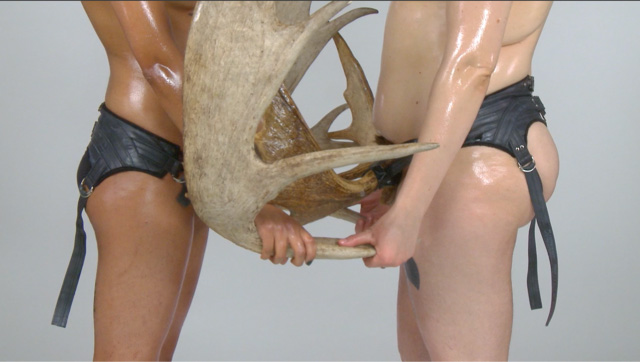 Dayna Danger, Bebeschwendaam, 2017. Video still. Courtesy the artist.
Dayna Danger, Bebeschwendaam, 2017. Video still. Courtesy the artist.
